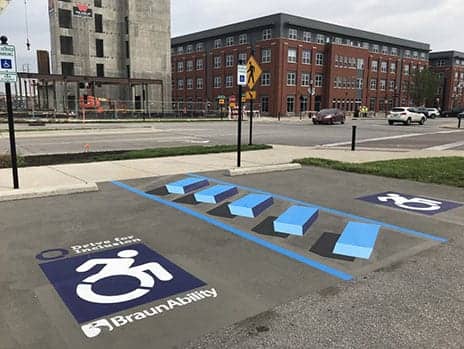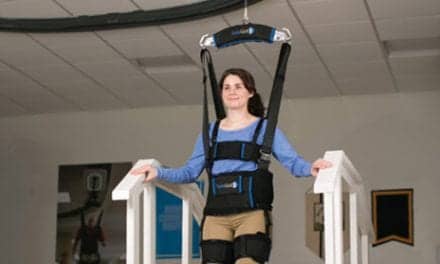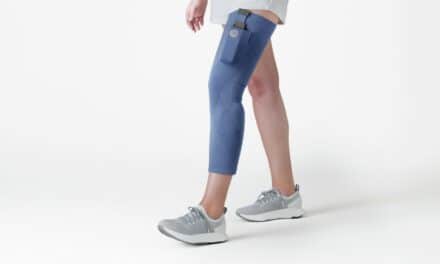
BraunAbility marks the launch of its Drive for Inclusion campaign with what it describes as reportedly the first-ever 3D accessible parking design, which debuts in the Indianapolis metro area. (Image courtesy of BraunAbility)
BraunAbility launches Drive for Inclusion, an effort to gather and unify the voices of people across the mobility disability spectrum to take action for greater access, and ultimately inclusion, for anyone living with a mobility challenge.
The launch is just ahead of the Indianapolis 500 in May, which is also National Mobility Awareness Month.
As the campaign’s inaugural action, the Indiana-based mobility transportation solutions provider partnered with Speedway Ind, to trial a new 3D accessible parking design at the front door of the Indianapolis Motor Speedway.
“The purpose of creating a 3D accessible parking design is to bring attention to just one of the many everyday issues faced by people who use wheelchairs that goes largely unnoticed by the general public,” says BraunAbility CEO Staci Kroon, in a media release.
“People with mobility challenges deserve to live in a society that is inclusive of every mobility level, yet today, more than 1 in 3 people show an unconscious bias against those with a disability. That’s higher than levels of bias on the basis of gender or race.”
While progress is being made in several areas around diversity and inclusion, many of the daily obstacles that prevent inclusion for people with mobility disabilities, which affect one in eight adults, are largely ignored by society as a whole. BraunAbility launched Drive for Inclusion to ensure these challenges are heard, shared, and used to fuel conversations and actions that increase inclusion.
Accessible parking abuse is one of the most common issues BraunAbility hears from its customers. In fact, 84% are interested in actions aimed at preventing misuse of accessible spaces. More broadly, accessible parking abuse has been witnessed by 74% of participants in recent US survey, the release continues.
To create awareness of this issue, BraunAbility enlisted the talents of internationally renowned artist, Tracy Lee Stum, to redesign the access aisles found next to wheelchair van accessible parking spaces. The 3D optical illusion of a raised barrier is designed to stop someone from parking on the access aisle, keeping the space open for a wheelchair van ramp to deploy.
BraunAbility invites anyone living with a mobility disability and their caregivers to share their voices through its online survey community The Driving Force and provide input on obstacles they face in their daily lives and what changes could lead to greater mobility inclusion.
The information gathered through the community will be used to inform future actions that will be championed by BraunAbility, and key findings from the survey community will be released annually through the Drive for Inclusion Report Card beginning in May 2020, the release explains.
“The ADA has been in place for nearly 30 years, and yet, people with mobility disabilities, like myself, face unnecessary burdens in our daily lives — from lack of employment opportunities to having to enter a building through the back door where the wheelchair ramp is located,” states Sam Schmidt, Drive for Inclusion advisory board member and 2019 Grand Marshall of the Indy 500 Festival Parade.
A former IndyCar driver, Schmidt became a quadriplegic after experiencing an accident during a practice session in 2000. “I am extremely proud to be a part of this movement as one of the first The Driving Force members because when voices of those with mobility disabilities are included, all of society benefits.”
If proven successful, BraunAbility will encourage other businesses to incorporate the 3D access aisle into their parking lots. The company, which it reports in the release will soon move its global headquarters to Carmel, Ind, has plans to test the 3D access aisles in more communities later this year and will expand its employee volunteer efforts around mobility inclusion in communities across the country.
“Inclusion for people who use wheelchairs or who have mobility challenges can only be possible when everyone is able to fully participate in society, without discrimination, and the barriers preventing inclusion due to bias, lack of understanding, or inadequate access are removed,” Kroon comments.
[Source(s): BraunAbility, PR Newswire]




